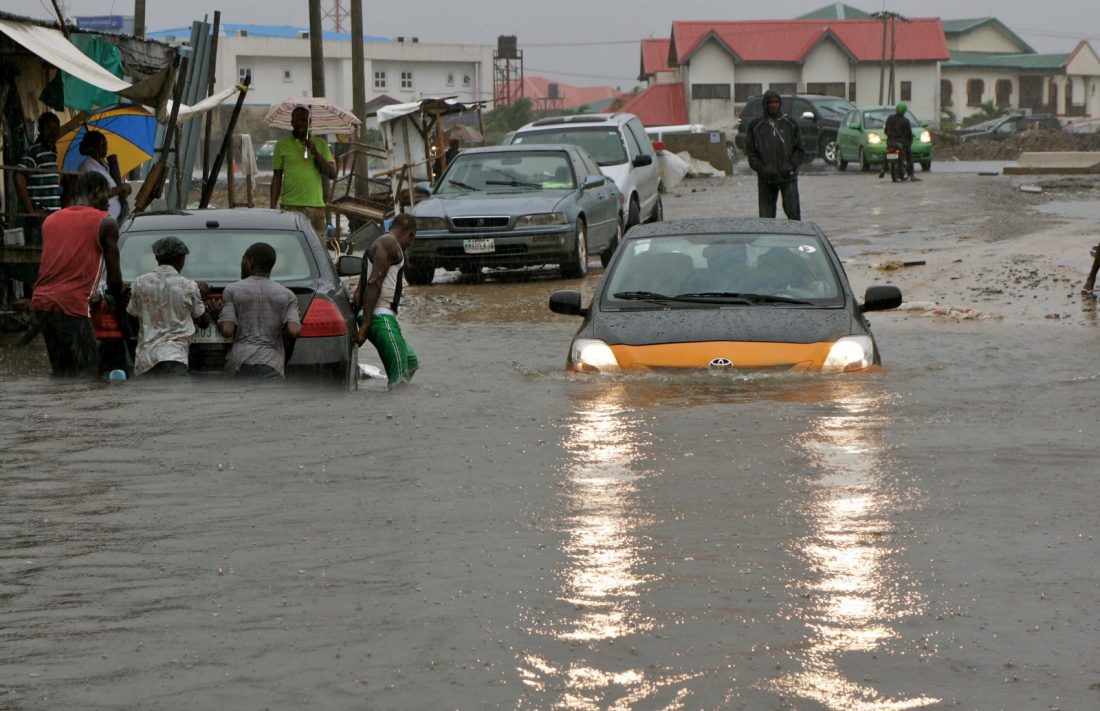The National Emergency Management Agency, NEMA, has disclosed its readiness to mitigate this year’s impact of flooding in 102 local government areas spread across 28 states of the Federation.
AVM Muhammadu Muhammed, the director-general of the agency, disclosed this in a statement on Friday, July 10, 2020, in Abuja.
He said according to the World Health Organization WHO, between 1998-2017, floods affected more than 2 billion people worldwide and 80-90% of all documented disasters from natural hazards during the past 10 years have resulted from floods, droughts, tropical cyclones, heat waves, and severe storms.
“Nigeria has experienced its own share of flood disasters over the years. The unprecedented flood of 2012 that ravaged most parts of Nigeria affected over 7 million people.
It displaced 2.3 million people, killed 363 persons, and destroyed or damaged about 597,476 houses in 34 States with estimated damage and loss of N2.6 trillion.
The overall impact of the 2012 flood according to the Post Disaster Needs Assessment conducted that year on real GDP growth was estimated at 1.4 percent i.e. N570 billion in nominal terms.
“Similarly, in 2018, another devastating flood occurred in more than twelve states of the Federation. The flood-affected 2,321,592 people, killed 199 people and displaced 722,741 people.
Also, 4,107 people were injured with a total of 100,190 houses destroyed. “Sadly, Nigeria also experienced flood in 2019.
Our record showed that 130,934 people were affected while 48,114 persons were displaced and 126 people were killed. It also damaged 29,356 houses.
“Unfortunately, 2020 is going to be a year of ‘an incident within an incident’. With the Country battling the Covid-19 pandemic, managing a flood disaster will be a herculean task.
“The Nigerian Meteorological Agency and the Nigerian Hydrological Services Agency released the 2020 Seasonal Rainfall Prediction and the 2020 Annual Flood Outlook respectively.
According to 2020, the general outlook of annual rainfall amount is predicted to be normal to above normal in Nigeria, thus some places are expected to have above-normal rainfall which may result in floods in 2020.
“Correspondingly, the 2020 Annual Flood Outlook forecasted flooding in some parts of the country where 102 LGAs in 28 States fall within the Highly Probable Flood Risk areas, while 275 LGAs in the 36 States of the Federation including the FCT fall within the Moderately Probable Flood Risk areas.
The remaining 397 LGAs fall within the Low Probable Flood Risk areas.
These predictions are expected to have an impact on various sectors including Agriculture, Water Resources, Health, Transport, and Infrastructure”, he added.
AVM Muhammed said NEMA has constituted a Committee to lead the National Preparedness, Mitigation and Response to 2020 flood apart from organising a stakeholders’ Experts Technical Workshop in March to analyze the Nigerian Meteorological Agency’s 2020 Seasonal Rainfall Prediction and developed the disaster risk management implications “We produced and disseminated the Disaster Risk Management Implications of the 2020 Seasonal Rainfall Prediction Early Warning Messages to relevant Stakeholders.
“We have started Public Enlightenment Campaign (i.e. Radio & TV jingles, Social Media etc), targeting vulnerable communities to undertake mitigation actions and prepare for evacuation to safer ground; Stockpiled relief materials (Food & Non-food items) that will be needed in providing succor to people that may be affected;
“We have also written letters to inform all the State Governors indicating the LGAs that may be affected by the flood and also suggested the proactive mitigation measures that are expected to be taken, which include: inform the State Emergency Management Agencies, frontline LGAs and other response Agencies to prepare and carry out enlightenment campaign, targeting vulnerable communities to undertake mitigation actions and prepare for evacuation to safe ground” Muhammed said.
Other steps taken to mitigate the effect of this year’s flooding includes identifying high grounds for possible IDP Camps to shelter evacuated communities; desilting of river channels and canals; removing refuse, weeds, water hyacinths and floats from water channels, drainages and on all avenues for the free flow of floodwater among others.
Other intended plans of action by the Agency include “identification of relevant stakeholders and their equipment holding that can support response to the flood; Convening a Flood Management Stakeholders’ Consultative Forum to deliberate on national Preparedness, Mitigation, and Response; Paying advocacy visits to the Military Disaster Response Units and other relevant stakeholders to ensure they are prepared for response.
“If the flood leads to the displacement of people, they may need to be sheltered in IDP Camps where people will be in close contact. With the already overstretched health infrastructure, this will lead to a complex humanitarian situation.
“In the light of the above, all hands must, therefore, be on deck to ensure that we prepare well to mitigate the impact of the predicted 2020 flooding even in the midst of Covid-19 Pandemic”, AVM Muhammed added.
Source: Vanguard







